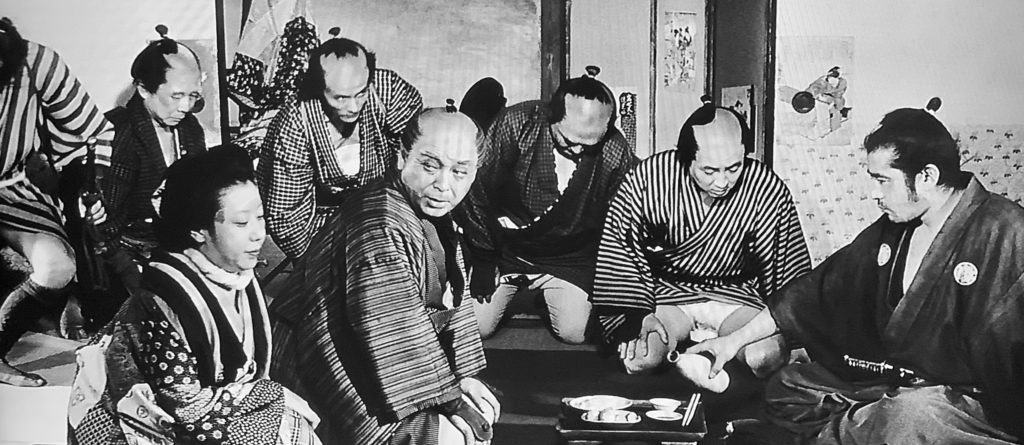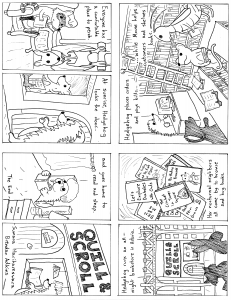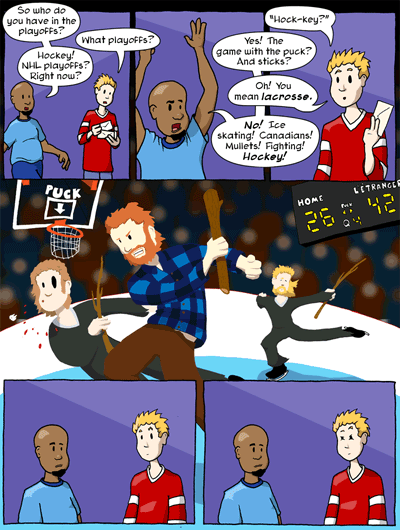I’ve been a fan of Magnolia Porter Siddell for a long time. Today she posted the last page of Monster Pulse, making it one of the only webcomics I have ever seen tell a cohesive, consistent, and conclusively satisfying story via the steady mechanism of Monday-Wednesday-Friday updates over the course of years. Ten years! That’s an extraordinary achievement, even apart from the sheer wonder and grace of her storytelling, and I think it’s one of the great success stories of the medium in the 2010s. Porter Siddell pursued evolution and risk in her art, stayed true to her inspirations while exploring far beyond their boundaries, and never let her readers down. I can’t wait to buy the print editions all over again. Re-read Monster Pulse!
Category: Toons
Again, Juvies
-
Spider-Man: Far From: Home (20:19): You can probably skip down to Yojimbo (1961), this part is a nerd trap and I’m still caught in it. Also it’s full of spoilers, if you care about that.
This purports to be a movie about the consequences of Tony Stark’s death, but even more present are the ghosts Stan Lee and Steve Ditko, who created Spider-Man together and both died in 2018. Whatever any given audience thinks of Lee, the people behind the Marvel Spider-Man movies were clearly big fans; the license plate and wrestling poster Easter eggs alone are indication of that, and the big hallucinatory illusion sequence in the second act is a big ol’ fanvid drawn straight from the Lee/Romita on-page experiments of the early 70s. I think it does Doctor Strange, another Lee/Ditko creation, better than Doctor Strange (2016) did. Sooo when you include a subplot about disgruntled people whose work was subsumed or absorbed to promote one man’s self-made aura of genius, it’s hard not to see another side of that too. There might be a movie out there that can sell me on the idea that the correspondence was deliberate, but as much as I enjoyed it, Far From Home is not that.
There’s a lot going on in the movie thematically and none of it quite gels. Is this a movie about people needing to move on? That topic keeps coming up but never gets an emotional climax. Is it a movie about how drones are bad? It’s certainly not the first Marvel film to express that unease, but why does it go unremarked that Tony Stark apparently built a global pinpoint-assassination system just like the one Steve Rogers was willing to die to destroy in The Winter Soldier (2014)? Is it a movie about whether Peter Parker—who, in current comics canon, operates a multinational tech corp in very Starkian fashion—is meant to step into his dead mentor’s role? Kind of, but that shouldn’t even be a question the MCU has to ask, because the MCU already has an established born leader and tech wunderkind for its next phase of superheroes. Their names are T’Challa and Shuri!
Is it a teen road movie? No, it backgrounds all of that in favor of very expensive-looking effects sequences. Is it a love story? Almost, almost. Tom Holland and Zendaya have about three scenes together, and they’re electric! Those two people are very good at acting! You have to have something special to actually sell me on a Peter/MJ romance in two thousand damn nineteen, and they did, but in true Sirius Black fashion, we barely get to glimpse the good stuff before it’s gone. A big flaw in the movie is how it continues the timeworn MCU tradition of failing to foreground its women; it needs not only more Zendaya, but more Cobie Smulders, and any at all of Jennifer Connelly, and more Marisa Tomei. How are you going to make a movie set in Venice with Marisa Tomei and ghost Robert Downey Junior in it and not even throw in a sly reference to Only You (1994)?
Anyway, since I started drafting this post the movie made a billion dollars, so Marvel/Columbia/Sony are probably pretty happy with Jon Watts and his directorial choices overall. I just liked Homecoming so much, and thought this showed such potential to be a movie specifically suited to my tastes, that I have a hard time not wrestling with the things it wasted and missed. NERD TRAP OVER.
-
Yojimbo (1961): Man, just look at this.

There are eight people in this shot, where one of the contenders for town boss is receiving Toshiro Mifune’s ronin and wheedling for his services. I didn’t do anything special to grab this frame—I just paused my player and took a photo of the TV with my phone, like a monster.
For the majority of people, color is a critical component of the way we separate shapes from each other, figure out what to pay attention to, and—like it or not—assess others. This image has no color dimension. But because its costume design is brilliant, my eyes immediately parse each person in the shot, and it’s even easy to grasp their ranks: the boss and his wife have the most ornate clothing, the ronin wears simple solids, and the background lieutenants each get a distinguishable but undistracting pattern. Because it’s blocked well, I know right away that Mifune is the center of the scene, with everyone else’s attitude cheated toward him. I happened to catch a frame where most of the lieutenants are looking down as they settle in, but the three principal characters always have their faces in full view or profile, so your brain can follow the conversation between them without the need to reverse between close-ups.
It’s fun to be able to break that out after the fact, and it’s even more fun to get picked up and carried along by it in motion. There’s all kinds of STUFF in Kurosawa movies: moving weather, moving fabric, bold expressions and exaggerated gestures and all kinds of people on the screen. Heck with minimalism! It’s great when the frame is busy, as long you can do it in a way that works for the viewer instead of against them. Anyway this movie is good and cool.
- The Old Man and the Gun (2018): I guess it could just be the Robert Redford fan in me speaking, but I certainly enjoyed this Robert Redford movie about movie star Robert Redford. It’s full of winks, but I was surprised to learn that casting Sissy Spacek opposite him was not one of them. They’d never been in a movie together before! They have wonderful chemistry, and I would have liked more of that instead of Casey Affleck’s dogged-mopey subplot, although his family was cute. When in doubt, always replace Casey Affleck with Sissy Spacek. Call that “the ek-eck rule.”
- Uncle Boonmee Who Can Recall His Past Lives (2010): This is a movie against which one critic’s epithet of “Uncle Bong Hit” can be… fairly applied. Also I really enjoyed it. The first shot in which the camera moves at all is fifty minutes in, and I’m not sure there was a single shot that lasted less than ten seconds in the whole thing; the median edit seemed somewhere around two minutes. It probably goes without saying that the only music is diegetic. Imagine those being your constraints. Imagine having that much confidence in your composition!
- Happy-Go-Lucky (2008): After talking a big game about my admiration for Sally Hawkins I decided I had to back it up by watching her breakout role, which is also my first Mike Leigh movie. Hawkins is extraordinary as expected. I knew that Leigh’s process of rehearse-improvise-rehearse-THEN write-THEN film was a whole unique thing; I did not know that the rehearsal process for this movie would have been happening while I lived in London in 2007. (I recognized zero locations aside from Hyde Park, but London is big and I lived south of the Thames.) This movie takes its time to get going, and anyone less charming than Hawkins in the lead could have grated a bit, but it’s lovely. Who else is going to make a movie that amounts to “a kind person politely and successfully asserts boundaries against hostile men, the end?”
- The Iron Monkey (1977): There are about forty movies called Iron Monkey and this is not the one directed by Yuen Woo-Ping, it’s one that was alternately titled Monkey Fist Vs. Eagle Claw and screened for the Hollywood’s monthly Kung Fu Theater night. Aside from the part where it shows a CHILD GETTING STRANGLED ON SCREEN in the first act, it’s pretty much what you’re there for.
-
Predator (1987): I love Alien (1979) and that franchise has long been a point of comparison against this one, so I decided to watch this. I didn’t like it. All right, John McTiernan, I hear your latter-day argument that this movie has some satirical intent behind it: the scene in which the bulging shout-men clear-cut an acre of rainforest using infinite bullets actually does trample right past power fantasy into grand display of impotence. It is goofy, but what does it end up saying by the end? That when the mechanized instruments of murder fail you, you must turn to… less mechanized instruments of murder? That beneath the ugly mask of sport hunting is… a face that is also ugly? I don’t buy it! This movie wants to stab its cake and shoot it too.
My favorite part was the special effects, which I think have now crossed a line from “dated” into “gloriously retro.” I spent most of the runtime thinking about the ways in which the Predator is shown to be a peerless hunter of men, to wit:
- outnumbered and outgunned at all times
- water-soluble camouflage
- glowing blood for convenient tracking
- slow-moving, light-up bullets for easy location in a firefight
- tall-ish?
- bound by strict rules of chivalry
- cannot chew food
- legally blind
- frequently sleepy
Damn, Arnold, you really skinned your teeth on that one.
-
Point Break (1991): See, with this one I can give credence to a certain archness of regard! Among Kathryn Bigelow’s other movies, I have only seen The Hurt Locker (2008), but that alone gave me reason to think she had a more nuanced understanding of masculinity than the other John McTiernan movie I have seen (Die Hard [1988]).
Contemporaneous reviews of this movie seem to have missed the homoerotic frisson that overlays the entire thing, not to mention the way the film keeps rolling its eyes at the incompetence of the FBI characters and the surfer gang’s bullshit philosophy. This is a movie shot by someone who had already watched many men’s eyes glaze over as they stopped listening because they believed they had something more important to say. The silent camera, in fact, plays with everyone here like a superior dance partner, and that’s one thing the reviews did notice—technically, the surfing and skydiving and chase sequences must have been fucking hard to shoot! There was no bullshitting with CGI in 1991, and no infinite digital storage either. For every perfect curl we get to see someone riding through in slow motion, someone else was doing the same thing, holding a camera, with a limited amount of celluloid film in a canister, backwards.
I loved this movie even though it had almost zero women in it. And having watched it, I’m now convinced that Bigelow invented the so-called Sorkin walk and talk!
- Perfect Blue (1997): It’s 1:30 in the morning and I really want to finish this roundup because it’s also almost September! This movie has sexual violence in it. It is really interesting to compare to Paprika (2006), not only for to see how far Satoshi Kon and Madhouse came as animators in ten years, but to see Kon developing what between them amounts to a career-length treatise on the Kuleshov Effect.
- High Flying Bird (2019): This movie was aaalmost ruined for me by an airbnb TV with motion smoothing turned on that I could not disable. It’s also one of two movies I watched this month that were shot on iPhones, and despite the fact that I love this cast (André Holland! Zazie Beats! Melvin Gregg from American Vandal!!) and this playwright (Tarell Alvin McCraney!!!) and of course this director, it was not the one I preferred. I enjoyed its subtle conceit about the long work of revolution, and its performances, but the decision to shoot everything in extreme wide angle with a single anamorphic lens is hard to handle. You can strap a telephoto onto an iPhone too, Steven! I really think at this point in his career that Soderbergh enjoys being able to execute what he wants very, very fast—they self-funded and shot a feature film on location in something like thirty days—and the result is not sloppy, but its spontaneity in form is a little at odds with its deliberate function.
- Tangerine (2015): See, now, this is how you shoot a movie on a phone. Grainy, artificially warm, hectic, rife with bad decisions, full of characters who see the world through this exact same lens, and fun as hell. There is homophobia in this movie and use of the n-word by white people, but it is not sexually violent, which was a relief to me. It’s on Hulu! Text me if you want my password.

Quill & Scroll
In December my friend Sumana came to visit me. I have a longer entry to write about her, but I want to publish this one first. One night as we were hanging out at my house, she asked if we could make something together. So we got out pencils and paper and we did!
What we made was zine, a sort of companion piece to a zine she worked on with a different friend about animals who run bookstores in the Bay area. This one is about an all-night animal bookstore in Astoria. Sumana wrote it and I drew the pictures, and—I must emphasize this—it is completely adorable.
You can download it and print it out yourself if you would like to. It’s in the “8-sided zine with one cut” format, no tape or staples necessary. Here is the Quill & Scroll PDF and another PDF with no margin, which may make for easier printing. And here it is as an image.
This work is released under a Creative Commons Attribution 4.0 license.
The time, the distance and the price
This post contains spoilers for Constellation Games up through chapter 30, but it’s not really a Constellation Games post; it’s about Starslip, and contains spoilers for its ending.
I’ve connected the work of Kris Straub and Leonard Richardson before, and not just because they both wrote serialized stories that trade heavily on the importance of artwork in space, calling things into being with poetry, and a pure-thought immortal hivemind end-stage of all life protected by a group of mortals. I could do that thing where I try to assert that they both take place in the same fictional universe, but I’m not going to, in part because the idea of hopping around between infinite possible universes is kind of the point of Starslip.
But I do think they have one thing in common, across all of those:
“The One True Pairing phenomenon is real, but it’s a curse. Any two parties so affected are the Keymaster and Gatekeeper of a door that opens into stark, existential horror.”
“Wherever there is a Memnon Vanderbeam and a Princess Jovia, the former seeks the latter. And they never get together. It just. Doesn’t. Happen.“
The last Starslip is bittersweet, and a lovely conclusion to a long story. The subtext of the whole conclusion arc, though, is incredibly dark. Out of all infinity, there is exactly one timeline in which Vanderbeam saves Jovia, and he has to make enormous sacrifices to do so, including his own life. The comics we saw in Starslip depict that timeline, but what happens to them in the uncountable others? Uh, this kind of thing.
That’s what I think Jenny and Ariel understand when they kiss. Ariel sees the horror, the mind-destroying vastness of possibility in which they will always be apart. Jenny sees the hilarious impossibility that maybe this is the right timeline, and Copernicus is wrong, and they are the center of the universe after all.
I think that at the beginning, Starslip’s daily punchlines masked the weight it carried in its core, but it carried it all the same. The impact of that weight landing, seven years on, was incredible. It deserves assessment, and I hope to be able to give it some as it restarts its run from the beginning as (!) a syndicated comic. Re-read Starshift Crisis.
I lied about Eminem being my spirit animal. Cleo is my spirit animal.
My favorite comic strips always go away! I am very sad about Bobwhite ending; it will leave a sore and empty socket in the jawbox of my daily comics list. For years it has been the funniest, smartest, most personal two minutes of my morning, and it was a privilege to read.
Unlike the bad old days, though, now when comic creators stop doing one strip they start another! I don’t know if Magnolia’s new Monster Pulse will ever replace Bobwhite in my heart, but I will pretty much follow her work anywhere at this point. The same goes for Kris Straub, of course, and F Chords has suddenly sprinted up to become my favorite outlet of his, with a distinctly more personal tone that echoes a little of what he used to do in Checkerboard Nightmare. So fucking go there already, I’m tired of telling you dicks.
As long as I’m plugging things my friends did
Jake Richmond has a great new webcomic called Modest Medusa! Based on true life events! Except the part about the medusa.
Josh Timonen, quantum coworker, made an iOS app called FaceJack! It is essentially the executable form of this:

And it’s an instant hit at parties. I recommend it.

